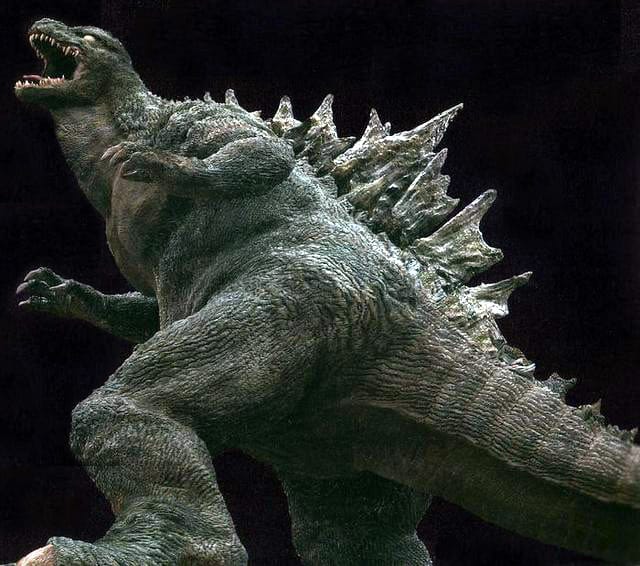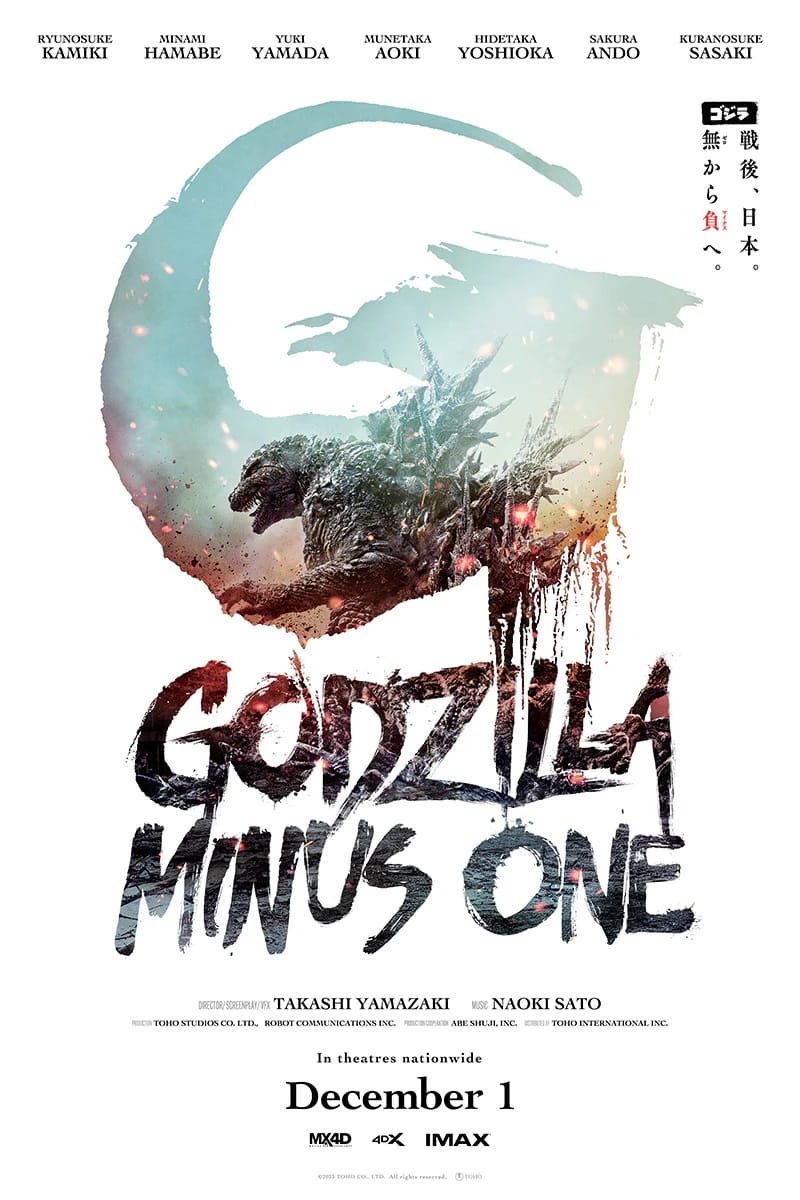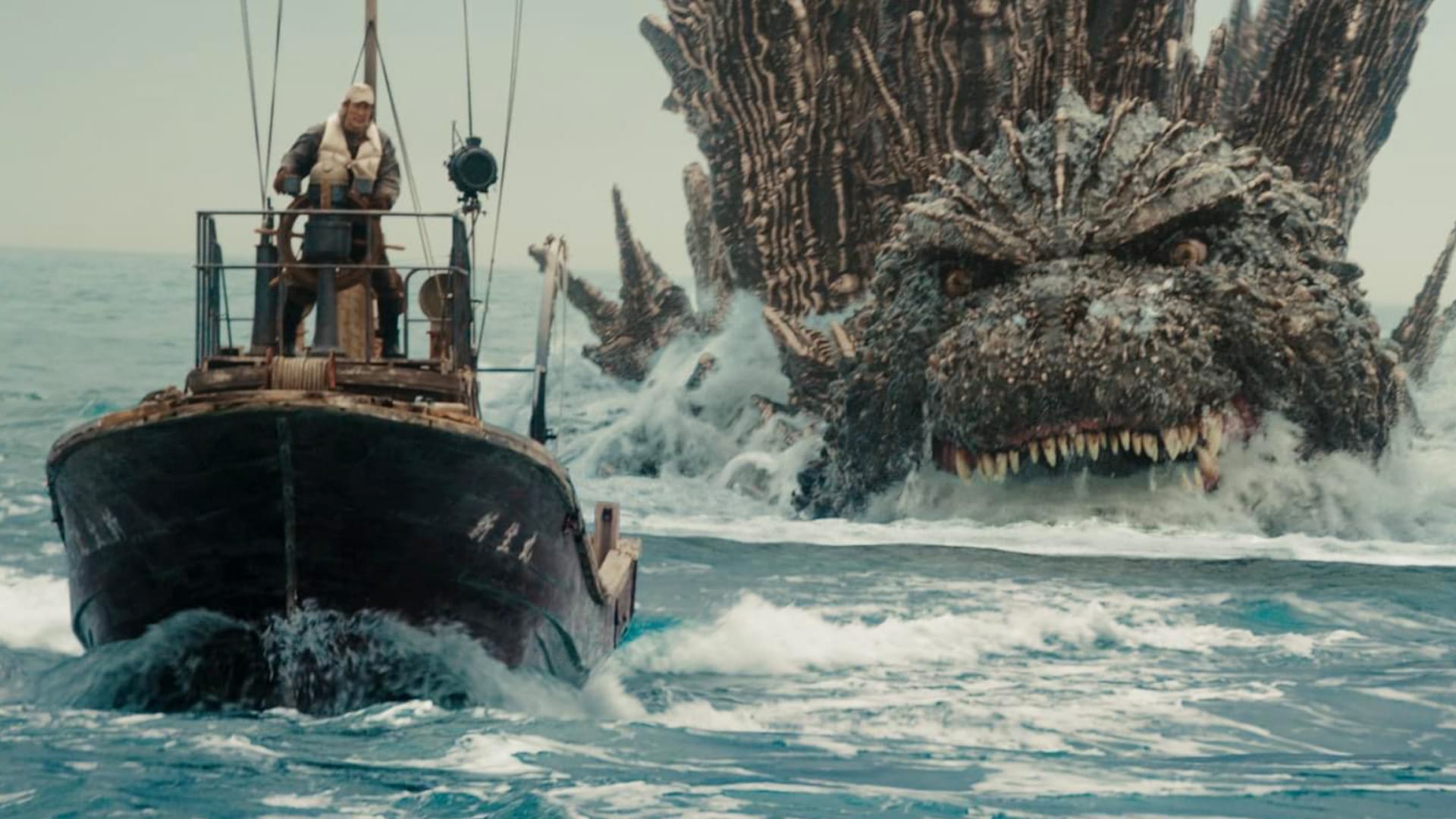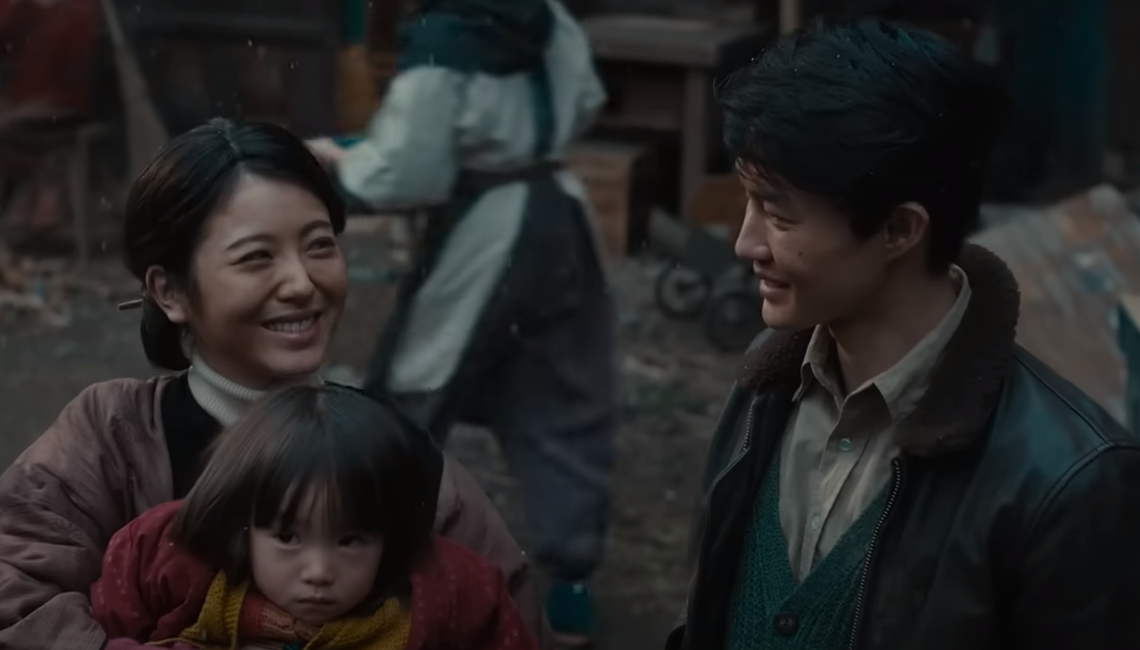This past week marked the North American release for the latest Toho produced Godzilla film, Godzilla -1.0. Interestingly, this film was somewhat made in secret, as it was not officially revealed until filming ended in 2022. Although, its existence was announced in February that same year under the working title, Blockbuster Monster Movie, as speculation rose. Especially, since director of the Always: Sunset on Third Street films, Takashi Yamazaki was heavily attached to this production. For those unaware, in series’ second film, the movie opens on a writer’s dream of a Godzilla attack. Coincidentally, when that scene hit YouTube around 2007-10, fans misidentified it as a proof concept for a CG Godzilla film.

However, other people may recognize Yamazaki for directorial roles on Space Battleship Yamato’s and Parasyte’s live-action adaptations. In addition, Yamazaki produced the CGI films Stand by Me Doraemon 1 & 2, and Lupin III: The First. So, needless to say, Yamazaki is a highly respected director and writer when regarding live-action or animated films. As a result, when producing this film, Yamazaki looks to retell Godzilla’s origin, as what if he appeared sooner. Specifically, by having Godzilla immediately attack Japan in 1947, a year after from being mutated during Operation Crossroads. Whereas, for Godzilla’s design, Yamazaki retooled the design he previously created for Seibu-en Amusement Park’s Godzilla the Ride. Although, there are some noticeable queues from the model Yamazaki used in Always 2 during some scenes. Also, the character features more radiation scaring than previous incarnations, mostly due to using its own heat-ray. Additionally, Godzilla’s regeneration ability is put on full display here, and it is visually similar to Marvel’s Wolverine. Furthermore, as the trailers imply, Godzilla’s dorsal plates do move when charging the beam, as an indicator for each use.
Now, as for the cast, it features actors who appeared in other tokusatsu productions like Kamen Rider, and Super Sentai. Specifically, its leads Ryunosuke Kamiki (The Great Yokai War, Kamen Rider Agito) and Minami Hamabe (Shin Kamen Rider). Also, Yuki Yamada (Gokaiger’s Gokai Blue) has a major supporting role in the film, and in every scene he shines. Furthermore, Kamen Rider Drive’s Kisuke Iida has a small supporting role as a member of Japan’s Godzilla countermeasures team. Ironically, when viewing the film, I could not recall which Kamen Rider series Iida was previously attached to. Then as for the remaining cast, it features Hidetaka Yoshioka (Yamazaki’s Always trilogy), Kuranosuke Sasaki, Sakura Ando, and Munetaka Aoki. Although, anime fans should recognize Munetaka Aoki as Sanosuke Sagara in the live-action Rurouni Kenshin films.
[Warning: The following contains spoilers, so please read with discretion]

Summary:
So, for the movie’s premise, as stated early it is what if Godzilla threatened Japan post-World War II in mid-1947. Yet, before we get there, the film opens during the final days of the war, and the months following it. Our protagonist Kōichi Shikishima (Ryunosuke Kamiki), a failed kamikaze pilot, lands on Odo Island looking to receive repairs. Although, Naval Serviceman Sōsaku Tachibana (Munetaka Aoki) realizes that Shikishima did not want to follow orders, and wanted an out. However, Tachibana begrudgingly lets that slide until a pre-mutated Godzilla destroys the base and leaves them as the sole survivors. Eventually, they are rescued and Shikishima returns home to discover everything in ruin from the American air raids. Coincidentally, his neighbor Sumiko Ōta (Sakura Ando), and others label him a coward when learning Shikishima was a kamikaze pilot. Furthermore, Sumiko tries to belittle Shikishima, as he reluctantly takes in Noriko Ōishi (Minami Hamabe) and her foster daughter Akiko. Thankfully, as time goes on though, they become a makeshift family realizing they need to rely on each other.
Meanwhile, as this makeshift family forms, Godzilla is mutated in Operation Crossroads, and Shikishima gets a government job. Interestingly, the job is being a minesweeper alongside former military veterans, Dr. Noda (Hidetaka Yoshioka) and Captain Akitsu (Kuranosuke Sasaki). In addition, they are joined by Captain Akitsu’s trainee Shirō Mizushima (Yuki Yamada), who starts off thinking war is cool. At least, Mizushima believes it until he learns about Shikishima’s PSTD from both the war and Godzilla. Coincidentally, Shikishima’s PSTD is also what stops him from accepting Noriko, as a lover or spouse, and Akiko as a daughter. Yet, once Godzilla makes his existence known to the world and attacks Japan, Shikishima’s mindset is forced to change. Especially, when Godzilla’s attack at Ginza separates Shikishima and Noriko, a private militia is formed to defeat the monster.
Surprisingly, Dr. Noda develops the plan to defeat Godzilla, which is the second-most creative method since Shin Godzilla. Specifically, Dr. Noda devises a plan to the compress and decompress Godzilla to nullify its invulnerability and regeneration. Whereas, Shikishima recruits Tachibana to help prepare a development jet to kamikaze into Godzilla’s mouth as a last resort. However, due to the militia wanting to ensure that no one dies in this operation, Tachibana installs an ejection seat. Especially, since many of the veterans began realizing how taxing the war truly was for them and other citizens. As a result, they are doing this counteroperation for themselves and the people, not specifically for their government. Whereas, when the plan goes into motion, it has a few hiccups like Godzilla arriving early and boats not working. Yet, both Noda’s and Shikishima’s plan manage to defeat Godzilla, but the monster may have survived…
Review:
Now, the film incredibly depicts scenarios veterans had to face in a post-World War II, being labelled failures or cowards. Especially, when some of the work they could only obtain forced them into dangerous situations again like being minesweepers. However, the minesweeper profession helped to establish the comradery between Shikishima and the Shinsei Maru’s crew. Personally, I enjoyed how Dr. Noda and Captain Akitsu are mentors whose age allows them to accept their actions. Albeit, that Captain Akitsu is more hardened or aggressive of the pair, while Dr. Noda is the compassionate one. Whereas, Shikishima is a young middle-aged man having to come to terms with his past actions to overcome his PSTD. As a result, most of the film is spent on Shikishima looking to atone for his past mistakes. Interestingly, Shikishima’s story borrows elements previously seen in the franchise, particularly with the leading ladies of the Millennium Era. Meanwhile, Mizushima is the child of the team learning how war and general conflicts affect people differently. Surprisingly, their bond is best shown whenever they are confronting Godzilla, as seen with the Jaws-inspired battle at sea. Additionally, Dr. Noda’s charisma is what gets everyone motivated within the private militia, and gains Captain Hota’s (Miou Tanaka) support. Furthermore, Noda’s speech before their plan goes into motion is inspiring, and reminds of dialogue from Barefoot Gen. Particularly, lines by Gen’s father regarding his opinions on the war, and how people were being treated.

Then as for the romance between Shikishima and Noriko, it is rather odd to say the least. Like the first two trailers, made it seem that the relationship was much stronger and more present. Specifically, because their love develops as happenstance, but it seems Noriko is more smitten with Shikishima early on. Although, Noriko’s feelings are subtle until reminding Shikishima on how to get woman, and when she gets a job. However, many can argue that Noriko’s response to Shikishima’s PTSD outbreaks are signs of love, rather than just calming him. Interestingly, any signs of Shikishima wanting to reciprocate love is tied to overcoming his trauma and personal demons. Like Shikishima has the idea that if he cannot atone for past, then he should be truly happy. Yet, once their separation occurs, Shikishima adds his mistake of not admitting his love for Noriko into his personal war. So, Noriko and their foster child Akiko becomes Shikishima’s reason to live, even though he contemplates becoming a kamikaze again. Unfortunately, I slightly disagree with Yamazaki’s choice to reunite the family, as Noriko’s disappearance sparked Shikishima’s change. Personally, their reunite is too much of a happy ending, even though Noriko is implied to have received radiation poisoning.

For the special effects, the CG is not perfect the entire time, as Godzilla’s walking stands out the most. Like the walking looks as disjointed as the Shin Godzilla model during the Ginza attack, and towards the movie’s conclusion. Interestingly, the pre-mutated model moves the best since it acts more dinosaur-like, and it is very Jurassic Park-inspired. So, when Godzilla’s upper body is the focus, the movements look natural and the ocean scenes further help it. For example, when the Shinsei Maru battles Godzilla, I am unsure if physical props were made of its mouth. Also, I love how Yamazaki depicts Godzilla as not entirely invulnerable, as it gets phased and injured by weapons. However, it seems that as Godzilla progressively regenerates, he becomes more immune to the levels of artillery. Although, that is my interpretation, as many blasts were covered by the ocean’s waves, or the barrage of other shells. Additionally, as mentioned earlier, the way Godzilla uses his heat-ray is incredible as the dorsal plates act like pistons. Whereas, during the “death” scene, I like that Yamazaki was inspired by GMK because it is heavily apparent. Specifically, as Godzilla’s heat-ray tears his body apart once his head is severely damaged by Shikishima’s attack.
Surprisingly, the score was not very reliant on Ifukube’s tracks, but it did include some variations of the Godzilla suites. Interestingly, the composer was Naoki Satō, who has collaborated with Yamazaki previously on Space Battleship Yamato, and Parasyte. In addition, Satō scored the live-action Rurouni Kenshin films, and was the series composer on Pretty Cure until 2009. However, Satō’s original tracks for Godzilla Minus One are pretty good, but not too memorable without the accompanying scenes. Like even as I am writing this review, I am trying to memorize and study the score. Although, I feel that with multiple viewings of the film these tracks will gain a footing within fans’ memories.
Overall, Godzilla Minus One is an incredible installment within the franchise, and is a decent substitute for the original. Like this is a reboot that warrants sequels helmed by Yamazaki, and hopefully that will happen with its success. Although, if it does obtain sequels, I wonder if Yamazaki will choose to incorporate other iconic kaiju. Whereas, even if this is just another one-off film like Shin Godzilla, it will manage to stand on its own. Currently, Godzilla Minus One is somewhere within my Top 10 Godzilla films, but I am unsure of its placement. However, it may solidify or change when the movie eventually hits home video in North America. Yet, in the meantime, I heavily insist people should seek this movie out and view it in theaters.


![[Review] Godzilla -1.0: The New Face of Fear *Spoiler Warning*](/content/images/size/w800/godzilla-minus-one-review-thumbnail.jpg)
![[Review] Shin Ultraman: A Tribute to the Classic Series](/content/images/size/w600/shin-ultraman-fathom-events-preview-2.jpg)



